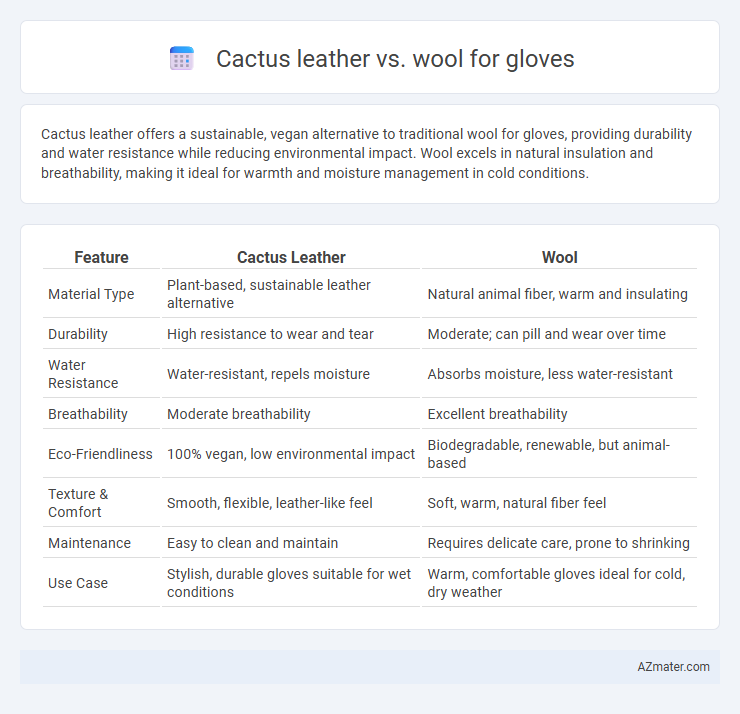Cactus leather offers a sustainable, vegan alternative to traditional wool for gloves, providing durability and water resistance while reducing environmental impact. Wool excels in natural insulation and breathability, making it ideal for warmth and moisture management in cold conditions.
Table of Comparison
| Feature | Cactus Leather | Wool |
|---|---|---|
| Material Type | Plant-based, sustainable leather alternative | Natural animal fiber, warm and insulating |
| Durability | High resistance to wear and tear | Moderate; can pill and wear over time |
| Water Resistance | Water-resistant, repels moisture | Absorbs moisture, less water-resistant |
| Breathability | Moderate breathability | Excellent breathability |
| Eco-Friendliness | 100% vegan, low environmental impact | Biodegradable, renewable, but animal-based |
| Texture & Comfort | Smooth, flexible, leather-like feel | Soft, warm, natural fiber feel |
| Maintenance | Easy to clean and maintain | Requires delicate care, prone to shrinking |
| Use Case | Stylish, durable gloves suitable for wet conditions | Warm, comfortable gloves ideal for cold, dry weather |
Overview of Cactus Leather and Wool as Glove Materials
Cactus leather, derived from the sustainable prickly pear plant, offers a vegan, eco-friendly alternative with natural water resistance and durability, making it suitable for gloves requiring flexibility and breathability. Wool, a traditional natural fiber from sheep, provides excellent insulation, moisture-wicking, and thermal regulation ideal for cold-weather gloves, though it lacks the water resistance and abrasion strength of cactus leather. Choosing between cactus leather and wool depends on the need for sustainability, weather protection, and thermal performance in glove materials.
Sustainability and Environmental Impact
Cactus leather offers a highly sustainable alternative to wool for gloves, as it is derived from renewable plant sources requiring minimal water and no pesticides, significantly reducing environmental impact. Wool production involves raising sheep, which contributes to methane emissions and requires large amounts of water and land, making it less eco-friendly. The biodegradability of cactus leather and its lower carbon footprint make it a preferable choice for environmentally conscious consumers seeking sustainable glove materials.
Durability and Longevity Comparison
Cactus leather offers excellent durability due to its resistance to wear, water, and abrasion, making it ideal for long-lasting gloves. Wool, while naturally insulating and breathable, tends to wear out faster under heavy use because of its susceptibility to pilling and moisture damage. In terms of longevity, cactus leather outperforms wool by maintaining structural integrity and appearance over extended periods in demanding conditions.
Comfort and Breathability in Gloves
Cactus leather offers excellent breathability and moisture-wicking properties that enhance glove comfort, making it ideal for all-day wear. Wool provides natural insulation and temperature regulation by trapping heat while allowing air circulation, ensuring warmth without excessive sweating. Both materials contribute to comfort, but cactus leather excels in breathability, while wool is superior for thermal comfort in colder conditions.
Allergenicity and Skin Sensitivities
Cactus leather offers a hypoallergenic alternative to traditional wool, reducing the risk of skin irritation and allergic reactions for sensitive individuals. Unlike wool, which can cause itchiness or exacerbate conditions like eczema due to lanolin content or coarse fibers, cactus leather is plant-based and free from animal-derived allergens. This makes cactus leather gloves an ideal choice for users with allergies or sensitive skin seeking comfortable and irritation-free wear.
Style, Texture, and Aesthetic Appeal
Cactus leather gloves offer a sleek, modern aesthetic with a smooth yet slightly textured surface that enhances subtle sheen and vibrant color retention. Wool gloves provide a classic, cozy texture with natural warmth and a soft, matte finish that exudes timeless sophistication. The choice between cactus leather and wool gloves ultimately depends on whether sharp, contemporary style or traditional, tactile comfort is prioritized.
Water Resistance and Weather Performance
Cactus leather offers superior water resistance compared to wool, making gloves crafted from cactus leather highly effective in wet and humid conditions. Wool provides excellent insulation and breathability but tends to absorb moisture, reducing its performance in rain or snow. For weather durability, cactus leather gloves maintain flexibility and resist wear better in harsh environments, while wool gloves excel in retaining warmth in cold, dry climates.
Maintenance and Cleaning Requirements
Cactus leather gloves require minimal maintenance, as they are naturally water-resistant and can be cleaned with a damp cloth to remove dirt or stains, avoiding harsh chemicals that might damage the material. Wool gloves need more frequent care, including gentle hand washing or machine washing on a delicate cycle with mild detergent, followed by air drying to preserve softness and prevent shrinkage. Both materials benefit from storing gloves in a dry, cool place to maintain their shape and durability over time.
Cost and Affordability Analysis
Cactus leather offers a sustainable and vegan-friendly alternative to traditional materials, with production costs typically lower than high-grade wool gloves, making it an affordable option for eco-conscious consumers. Wool gloves, especially those made from premium merino or cashmere, often carry higher prices due to the natural sourcing and processing involved, which impacts overall affordability. When comparing cost-effectiveness, cactus leather gloves provide durability and water resistance at a competitive price point, while wool gloves excel in warmth but may require a higher investment.
Ethical Considerations and Market Trends
Cactus leather offers an innovative, sustainable alternative to traditional wool by minimizing animal exploitation and reducing environmental impact through lower water usage and carbon footprint. Wool production often raises ethical concerns related to animal welfare, including practices like mulesing and shearing stress. Market trends indicate a growing consumer preference for vegan and cruelty-free materials, driving increased demand for cactus leather in glove manufacturing as eco-conscious fashion gains momentum globally.

Infographic: Cactus leather vs Wool for Glove
 azmater.com
azmater.com